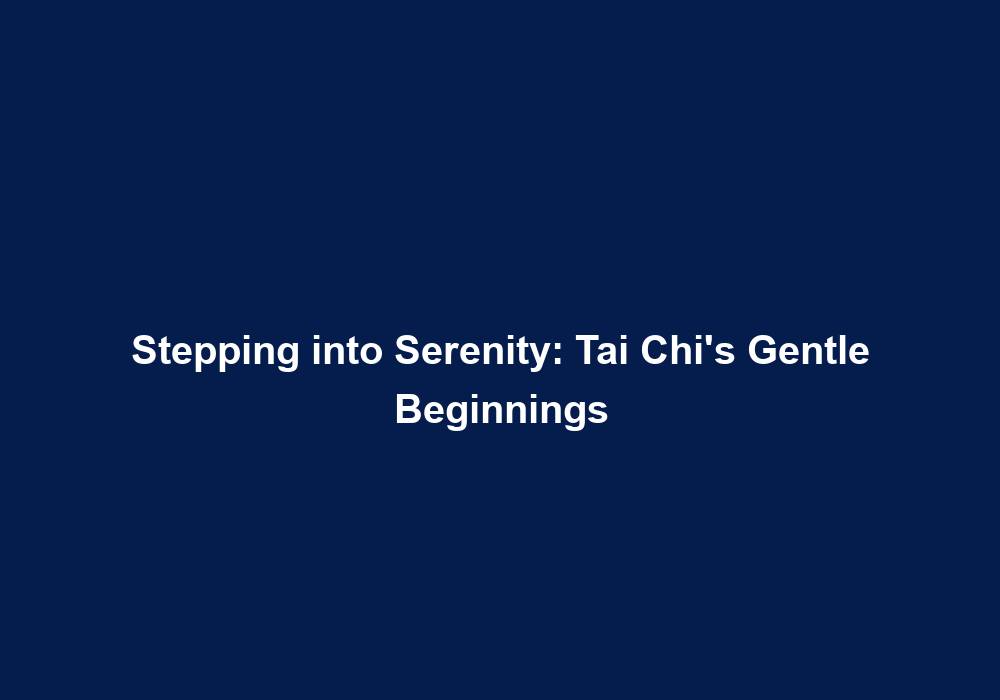Stepping into Serenity: Tai Chi’s Gentle Beginnings
Tai Chi, an ancient Chinese martial art, has gained tremendous popularity worldwide for its numerous health benefits and its ability to promote inner peace and serenity. Rooted in Taoist philosophy, Tai Chi combines gentle flowing movements with deep breathing and focused meditation, making it a holistic practice that enhances physical, mental, and spiritual well-being.
Origins and Philosophy of Tai Chi
Tai Chi, also known as Tai Chi Chuan, originated in ancient China during the 16th century. It was developed as a form of self-defense and a way to cultivate the mind, body, and spirit. The practice is deeply influenced by the principles of Taoism, which emphasize harmony, balance, and the continuous flow of energy or chi within and around us.
The philosophy behind Tai Chi is centered on the belief that the body and mind are interconnected, and that by harmonizing the movements of the body, one can achieve a state of balance and tranquility. The slow and deliberate movements of Tai Chi are designed to promote the flow of energy throughout the body, enhancing vitality and overall well-being.
The Gentle Movements of Tai Chi
Tai Chi consists of a series of slow, deliberate movements and postures that are seamlessly connected, creating a graceful and flowing sequence. Each movement is performed with mindful awareness, focusing on the alignment of the body, breath control, and the cultivation of inner calmness.
The practice of Tai Chi begins with a warm-up routine that includes gentle stretches and joint rotations to loosen the muscles and improve flexibility. This is followed by a series of movements, such as the “Grasp the Sparrow’s Tail” and the “Single Whip,” which are performed with slow, fluid motions. These movements are designed to enhance balance, coordination, and strength, while also promoting relaxation and mindfulness.
Benefits of Tai Chi for Physical Health
-
Improved Balance and Flexibility: The slow and controlled movements of Tai Chi help to improve balance and coordination, reducing the risk of falls, especially in older adults. By practicing Tai Chi regularly, individuals can develop a stronger sense of body awareness and improve their ability to maintain stability in various positions.
-
Enhanced Strength and Stamina: Regular practice of Tai Chi strengthens the muscles and improves overall physical endurance, making everyday activities easier to perform. The gentle resistance provided by the movements helps to tone and strengthen the muscles, while the slow and controlled nature of the practice builds stamina over time.
-
Joint Health: The gentle nature of Tai Chi exercises promotes flexibility and reduces stiffness in the joints, alleviating joint pain and improving mobility. The flowing movements of Tai Chi help to lubricate the joints, preventing the buildup of tension and promoting a greater range of motion.
-
Cardiovascular Health: Despite its seemingly low-impact nature, Tai Chi is an excellent cardiovascular exercise that increases heart rate, improves blood circulation, and lowers blood pressure. The combination of gentle movements, deep breathing, and mindful awareness activates the cardiovascular system, providing a gentle yet effective workout for the heart and lungs.
-
Stress Relief: Engaging in Tai Chi reduces stress hormones in the body, promoting relaxation and improving overall mental well-being. The slow and rhythmic movements, combined with deep breathing techniques, activate the body’s relaxation response, helping to alleviate stress, anxiety, and tension.
Nurturing Mental and Spiritual Well-being
-
Enhanced Mindfulness: Tai Chi encourages focused concentration and awareness of the present moment, fostering mindfulness and reducing mental distractions. By paying attention to the sensations of the body and the breath, practitioners develop a deep sense of presence, allowing them to let go of worries and concerns.
-
Stress Reduction: The slow, rhythmic movements of Tai Chi, coupled with deep breathing techniques, induce a state of relaxation and calmness, helping to alleviate stress and anxiety. This meditative aspect of Tai Chi allows individuals to release tension and cultivate a sense of inner peace and tranquility.
-
Mental Clarity: Regular practice of Tai Chi has been shown to improve cognitive functions, such as memory, attention, and decision-making, leading to enhanced mental clarity and sharpness. The combination of physical movement, deep breathing, and focused awareness stimulates the brain, promoting neuroplasticity and cognitive well-being.
-
Emotional Balance: Tai Chi promotes emotional stability by reducing the symptoms of depression and anxiety, and fostering a sense of peace and tranquility. The mindful and gentle nature of the practice helps individuals connect with their emotions, allowing them to process and release negative feelings, and cultivate a greater sense of emotional well-being.
-
Spiritual Connection: Tai Chi is often described as a moving meditation, allowing practitioners to connect with their inner selves and cultivate a deeper sense of spirituality. The practice encourages self-reflection, introspection, and a sense of unity with the surrounding environment, fostering a greater connection to the world and a deeper understanding of one’s place within it.
Getting Started with Tai Chi
If you are interested in exploring the world of Tai Chi and experiencing its numerous benefits, here are some steps to help you get started:
-
Find a Qualified Instructor: Look for a certified Tai Chi instructor who can guide you through the practice and ensure proper alignment and technique. An experienced instructor will be able to provide personalized instruction and help you progress safely and effectively.
-
Choose a Suitable Style: There are several styles of Tai Chi, such as Yang, Chen, Wu, and Sun. Research and try different styles to find the one that resonates with you. Each style has its own unique characteristics and movements, so it’s important to find a style that suits your preferences and goals.
-
Wear Comfortable Clothing: Opt for loose, breathable clothing that allows for unrestricted movement. Avoid wearing jewelry or anything that may obstruct your movements. It’s important to feel comfortable and free to move during your Tai Chi practice.
-
Start with Warm-up Exercises: Every Tai Chi session begins with warm-up exercises to loosen up the joints and prepare the body for the flowing movements to come. These warm-up exercises may include gentle stretches, joint rotations, and breathing exercises to help warm up the muscles and increase flexibility.
-
Practice Mindful Breathing: Focus on deep, slow breathing throughout your Tai Chi practice, allowing your breath to guide the rhythm of your movements. By synchronizing your breath with the movements, you enhance the mind-body connection and promote a state of relaxation and focus.
-
Be Patient and Consistent: Tai Chi is a lifelong journey, and progress may be gradual. Patience and consistency are key to reaping the full benefits of this ancient practice. Set aside regular time for practice, even if it’s just a few minutes each day, and be open to the process of learning and growth.
Conclusion
Stepping into the world of Tai Chi can be a transformative experience, bringing serenity, balance, and vitality to your life. Whether you are seeking physical fitness, mental clarity, or spiritual well-being, Tai Chi offers a gentle and accessible path towards holistic health. Embrace the flowing movements, breathe in the harmonious energy, and embark on your own journey of serenity with Tai Chi.







